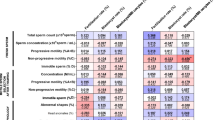Abstract
Background
Mitochondrial dysfunction has been suggested as a major cause of age-induced decline in oocyte quality. In the past, donor oocyte cytoplasmic transfer showed some success but was abandoned due to the concerns with heteroplasmy. Recent studies indicated presence of oogonial precursor cells (OPCs) in the human ovary, which could be an autologous source of “healthy mitochondria.” We sought to investigate the clinical efficacy of OPC-derived autologous mitochondrial injection (AMI) to improve oocyte quality in women with multiple in vitro fertilization (IVF) failures.
Methods
The OPCs were isolated from laparoscopically obtained ovarian cortical pieces by cell sorting using a monoclonal anti-vasa homolog (anti-DDX) antibody. They were then disrupted and mitochondria were isolated. Reconstituted mitochondria were injected into each oocyte during intracytoplasmic sperm injection. Paired comparisons were made between the first failed cycles and the post-AMI cycles.
Results
Of the 15 women undergoing ovarian stimulation, 2 were canceled and 3 decided to pool oocytes for later AMI. In remaining 10 (mean age 34.7 ± 4.1), AMI significantly improved fertilization rates (49.7 ± 31.3 vs 78.3 ± 18.9; P = .03) with a trend for better embryo grades (2.3 ± 0.3 vs 3.1 ± 0.7; P = .08). Four of 10 women conceived after single frozen embryo transfer and 3 after confirmation of diploidy via array comparative genomic hybridization (aCGH) (clinical pregnancy/embryo transfer = 4/10). Conclusion: These data show encouraging results for AMI in comparison to previous failed IVF cycles.
Similar content being viewed by others
References
Bentov Y, Yavorska T, Esfandiari N, Jurisicova A, Casper RF. The contribution of mitochondrial function to Reproductive aging. J Assist Reprod Genet. 2011;28(9):773–783.
Keefe DL, Niven-Fairchild T, Powell S, Buradagunta S. Mitochondrial deoxyribonucleic acid deletions in oocytes and reproductive aging in women. Fertil Steril. 1995;64(3):577–583.
Liu L, Trimarchi JR, Smith PJ, Keefe DL. Mitochondrial dysfunction leads to telomere attrition and genomic instability. Aging Cell. 2002;1(1):40–46.
Eichenlaub-Ritter U, Wieczorek M, Luke S, Seidel T. Age related changes in mitochondrial function and new approaches to study redox regulation in mammalian oocytes in response to age or maturation conditions. Mitochondrion. 2011;11(5):783–796.
Tilly JL, Sinclair DA. Germline energetics, aging, and female infertility. Cell Metab. 2013;17(6):838–850.
Oktay K. Ovarian tissue cryopreservation and transplantation: preliminary findings and implications for cancer patients. Hum Reprod Update. 2001;7(6):526–534.
Fujioka T, Yasuchika K, Nakamura Y, Nakatsuji N, Suemori H. A simple and efficient cryopreservation method for primate embryonic stem cells. Int J Dev Biol. 2004;48(10):1149–1154.
World Health Organization. Laboratory Manual for the Examination and Processing of Human Semen. 5th ed. Geneva, Switzerland: WHO; 2010.
Henkel R. Sperm preparation: state-of-the-art–physiological aspects and application of advanced sperm preparation methods. Asian J Androl. 2012;14(2):260–269.
Johnson J, Canning J, Kaneko T, Pru JK, Tilly JL. Germline stem cells and follicular renewal in the postnatal mammalian ovary. Nature. 2004;428(6979):145–150.
Pacchiarotti J1, Maki C, Ramos T, et al. Differentiation potential of germ line stem cells derived from the postnatal mouse ovary. Differentiation. 2010;79(3):159–170.
Bukovsky A, Caudle MR, Svetlikova M, Upadhyaya NB. Origin of germ cells and formation of new primary follicles in adult human ovaries. Reprod Biol Endocrinol. 2004;2:20.
Tilly J, Johnson J; Compositions comprising female germline stem cells and methods of use thereof. US patent number US7955846 B2, Jun 7 2011.
Van Blerkom J. Mitochondrial function in the human oocyte and embryo and their role in developmental competence. Mitochondrion. 2011;11(5):797–813.
Author information
Authors and Affiliations
Corresponding author
Rights and permissions
About this article
Cite this article
Oktay, K., Baltaci, V., Sonmezer, M. et al. Oogonial Precursor Cell-Derived Autologous Mitochondria Injection to Improve Outcomes in Women With Multiple IVF Failures Due to Low Oocyte Quality: A Clinical Translation. Reprod. Sci. 22, 1612–1617 (2015). https://doi.org/10.1177/1933719115612137
Published:
Issue Date:
DOI: https://doi.org/10.1177/1933719115612137




